Levi Wallick: 44th Indiana, Company K
Rank: Private
Place of first enlistment: De Kalb County: November 17, 1861
Mustered into Federal service: November 22, 1861
Reenlisted as a veteran soldier in Chattanooga TN: January 1, 1864
Mustered into Federal service for a second time: January 9, 1864
Combined service time: 3 years, 10 months
Born: c.1819-26 (discrepancy in records) Tuscarawas County, Ohio
Age at first enlistment: 34 or 35 years old
Height: 5’ 7", dark eyes, dark hair
Civilian occupation: Laborer
Proposed Family Lineage
Levi, son of Philip, son of "Bedford County" Michael, son of Esther and Hans Michael Wallick
Levi Wallick is a soldier with a mysterious life and lineage. All we know for certain about Levi is what he did during the four years of the American Civil War. This biography gives a proposed family lineage because there is no positive documentation connecting this Levi to any descendants of Hans Michael Walck/Wallick (1707-1767). But circumstantial evidence gleaned from Levi's war record, together with the genealogical work of Jeff Wallick, make a strong enough case to warrant his inclusion in these Civil War biographies. Below are two scenarios that could possibly connect Levi to the Hans Michael family.
When Levi Wallick enlisted in the Union Army in late 1861, he was living in DeKalb County, Indiana, a region where Wallick families were known to have lived for over a decade. One of the families was the clan of "Kansas" Benjamin, who moved his family to DeKalb County in 1850. By 1860 Benjamin’s family was living in the little village of Butler, Indiana, a mere eight miles from the settlement of Waterloo, where Levi was living at the time. There is no specific information to link Levi with Benjamin’s family, but it could be more than coincidental that the two lived within a short buggy ride of each other. Perhaps Levi was living in the area because he was a relative of Benjamin.
Another possible family affiliation that deserves serious consideration is that Levi may have been one of the sons of Philip Wallick (1783-1841). Philip first came to Tuscarawas County, Ohio in 1813, where he married his wife, Elizabeth Showalter, then quickly moved on to settle in northern Coshocton County. Only one descendent from Hans Michael Wallick, out of the hundreds that were born in the nineteenth century, had the given name Levi and that person was the first born son of Philip. The genealogical work of Jeff Wallick states that Levi was born in Coshocton County sometime between 1819-1823 and died after August, 1866. That is all we know about that son of Philip. What we know about Levi Wallick, the soldier, is what he states about himself in his enlistment papers: he was born in Tuscarawas County, he was 35 years old when he first enlisted in 1861, and his occupation was that of a laborer. Nothing more is known about the personal history of this soldier. Given that it is common to find errors in military records and that back then men would sometimes lie or not even know their true age upon enlistment, it is possible that Levi Wallick of the 44th Indiana could have been the son of Philip Wallick. Levi claimed himself to be a laborer. If he worked for others, he may have never owned any property of his own. If he were a bachelor, there would be no marriage documents and possibly no record of home ownership, a likely explanation for the sparse paper trail. Jeff Wallick’s materials state that the son of Philip was born in Coshocton County between 1819-1823, a pretty broad range for a birth date. The age for Levi the soldier is reasonably close to that of Philip's son, given that dates were notoriously inaccurate in the early nineteenth century. It is documented that Philip and Elizabeth were married in Tuscarawas County in February 1819 and that their first born was Levi. Perhaps he was born in Tuscarawas County before they moved to Coshocton County. The entire time frame is indefinite.
Whether Levi was related to Philip or “Kansas” Benjamin is secondary to the question of whether Levi is a descendent of Hans Michael Wallick. There is one piece of evidence, albeit circumstantial, that gives us good reason to believe he descended from Hans Michael. When Levi enlisted for the second time as a veteran, he listed his place of birth as Tuscarawas County, Ohio. That in itself may seem insignificant. However, for the past two hundred years every Wallick who was born in Tuscarawas County has descended from Hans Michael Wallick, with no exceptions. This fact alone is cause enough to have Levi included in this account of Wallick soldiers from the American Civil War. This author also believes that it is most likely that this soldier is indeed the son of Philip Wallick.
Levi Wallick's second enlistment papers are dated January 1, 1864 and state that he is 37 years old and born in Tuscarawas County, Ohio. For the past two hundred years every Wallick born in Tuscarawas County has been related to Hans Michael Walck/Wallick. This document also includes Levi's signature.

All of the above being said, the only recorded history we have of Levi Wallick's life is during his war years. He served in the Union Army longer than any other Wallick soldier, serving from November 22, 1861 until September 14, 1865. After Levi's discharge in Nashville, Tennessee, he is lost to history. There is no trace of him after the war in census records and he did not apply for any pensions from the War Department. It is hoped that someday new information may surface about Levi Wallick the civilian and what he did before and after the war.
Levi Wallick with the 44th Indiana Volunteer Infantry
1861
NOV 17 Levi Wallick enlists in the Union Army at Auburn, IN. He is owed a $100 bounty.
NOV 22 The 44th Indiana Infantry is mustered into Federal service at Ft. Wayne, IN.
DEC The regiment is posted at Henderson, KY.
1862
JAN Levi has duty at Calhoun, KY, then moves to northern Tennessee.
FEB 8 The 44th arrives at Ft. Henry, on the Tennessee River, as reinforcements for General Grant’s attack on that installation.
FEB 12 Attack and investments of Forts Henry & Donelson Admiral Foote’s gunboats bombard the Confederate forces at Ft. Henry and force them to withdraw twelve miles north to Ft. Donelson. These forts on the Tennessee and Cumberland Rivers were built to guard the two river passages that flow into the heartland of the Confederacy. With the surrender of Ft. Henry, central Tennessee and northern Alabama are open to Union conquest. General Ulysses S. Grant leaves the 44th Indiana at Ft. Henry while he moves the rest of his army to Ft. Donelson.
FEB 13 General Grant is in need of the forces he left at Ft. Henry for his attack on Ft. Donelson. The 44th Indiana is placed at the center of the Union line that surrounds the Confederate forces at Ft. Donelson. The Confederates also occupy the town of Dover, TN. Levi’s brigade commander is General Lew Wallace, who after the war will write the epic novel “Ben Hur.”
FEB 14 Admiral Foote’s gunboats attack Ft. Donelson but this time they are not successful in driving the Confederates from their fortifications. The Rebel forces return accurate fire from their large siege guns and this drives the admiral’s gunboats back with heavy casualties. During the engagement Admiral Foote is wounded in the foot.
The river battery at Ft. Donelson on the Cumberland River - Admiral Foote's flotilla of gunboats fired from the distant downriver horizon but was driven back by the Confederate defenders. The use of gunboats alone was unsuccessful in reducing the fort.
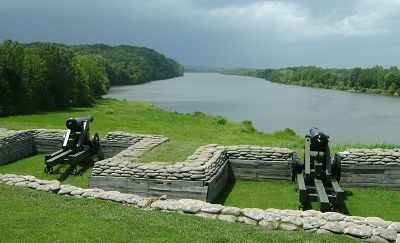
FEB 15 The Confederates realized the seriousness of their situation and try a breakout on the far right of the Union line. At first they succeed but then, for some inexplicable reason, they move back into their earthworks and do not exploit their advantage. Only General Nathan Bedford Forrest and his cavalry troops escape capture. He and his men will be a constant source of aggravation to Union commanders throughout the war and will capture and imprison two Wallick soldiers, William Wallick of the 51st Indiana and Elijah Wallick of the 102 Ohio Infantry. Levi Wallick’s regiment is ordered to attack and close the Confederate breakthrough which has taken place at the Cumberland River on the Union right. There is heavy fighting throughout the contest. At 2:00 pm the Union Army assembles a large force to close the Rebel escape route and pin the Confederate army in their earthworks. The 44th Indiana tips the balance of the engagement with an uphill charge near Forge Road. Thirteen-thousand Confederates are forced to capitulate and their commanding officer, General Simon Buckner, asks General Grant what are his terms for surrender. (Buckner and Grant were classmates together at West Point and Buckner even loaned Grant some money in the old days when Grant was quite destitute.) The Confederate general is anticipating generous terms. Grant responds, “No terms except an unconditional and immediate surrender can be accepted. I propose to move immediately upon your works.” Buckner found these terms both “ungenerous and unchivalrous.” This first major victory of the war for the Federals gives the North its first real hero, U. S. Grant. Church bells ring throughout the Union and his name is now recognized in every household. Grant's response to Buckner also creates for him a life-long moniker: Unconditional Surrender Grant. (To illustrate the unique times and valor of the men who fought in the American Civil War, General Buckner served as a pall-bearer at President Grant’s funeral, as a show of respect for the ex-President and hero of Ft. Donelson).
Dover House - site of General Buckner's unconditional surrender of Fort Donelson.
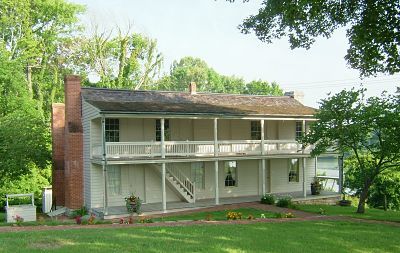
MAR 9-14 The 44th Indiana moves to Crump’s Landing on the Tennessee River.
MAR 16 Levi Wallick and the 44th Indiana have been organized into General Hurlbut’s Division and arrive by steamboat and disembark at Pittsburg Landing. Hurlbut’s Division makes camp at the south of the intersection of the Main Corinth Rd. and the Hamburg-Savanna Rd. It has been determined by Generals Sherman and Grant that the plateau at Pittsburg Landing will be an ideal place to train the vast numbers of raw recruits that comprise the Unions's western army. At this point in the war the Rebel Army is just as inexperienced as the Federals.
Background to the Battle of Shiloh or Pittsburg Landing
The Federal Army in Tennessee is split; half of its men are with General Grant and the other half are with General Don Carlos Buell. It is early April and the two are scheduled to rendezvous but have yet to do so. Most of Grant's troops have never experienced battle and some soldiers have never even fired their new muskets. These raw troops are surprised by a Confederate attack on the morning of April 6, 1862. The Rebel forces want to take advantage of the divided Union Army and destroy Grant’s forces before they can unite with General Buell. The general is making his way to Pittsburg Landing but has yet to arrive. Grant’s outnumbered troops must withstand a fierce Rebel assault and hold on until General Buell arrives.
APR 6, The Battle of Shiloh: First Day- 7:30 AM It is Sunday morning and Levi Wallick’s regiment is in a relaxed mode with no expectations of battle. They are positioned far to the rear of General Sherman’s frontline troops when they hear the sounds of musket fire and artillery. General Sherman has made his headquarters at Shiloh Methodist Church, a log cabin for worship (one of the many ironies of the Civil War is that the word "shiloh" in Hebrew means- place of peace). It is here that the battle begins and the 44th Indiana is quickly moved to a position north of the Peach Orchard and west of the Hamburg-Savannah Rd. They wait for orders to engage the enemy. At 10:00 AM General Hurlbut positions the 44th Indiana along a wagon road which runs between the Main Corinth Rd. and the Hamburg-Savannah Rd. This slightly depressed lane that runs through wooded terrain becomes known as the Sunken Road. Levi’s unit is on the Union left and north of the Peach Orchard. Here the fighting is fierce and the Federal Army must repulse repeated Rebel attacks. The bullets fly so thick that the Confederate soldiers refer to the sector as the “Hornets Nest.” The fighting rages from late morning to mid-afternoon and there are heavy casualties on both sides. At 2:30 PM General Hurlbut is forced to withdraw his troops before he is surrounded and captured in the Hornets Nest. The brigade to Hurlbut's right is under the command of General Prentiss. He and troops are engulfed and captured by the Confederates.
The Peach Orchard - New peach trees were planted in 2005 to restore the battlefield to its 1862 appearance.
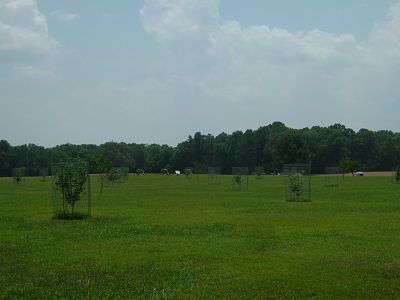
The Hornets Nest - where some of the most ferocious fighting took place at the Battle of Shiloh. The Union troops were perpendicular to the camera, firing from right to left.
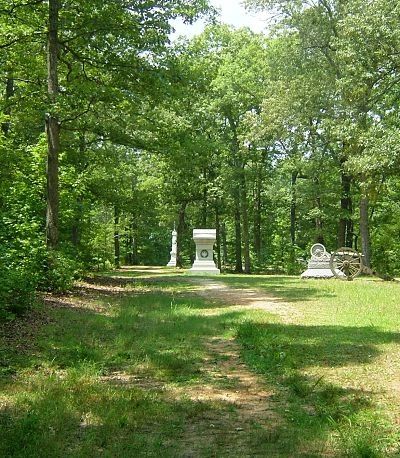
This monument to the 44th Indiana Infantry can be found
by following a secluded path in the Hornets Nest.

Back of the monument

This regiment formed in this line Sunday, April 6, 1862. At 8:30 A.M. it repulsed several charges made by the enemy, including four terrific charges by right of Gibson's Brigade which, under orders of General Bragg, was attempting to force this line back. During these engagements the woods caught fire. At 2:30 P.M. regiment fell back to a line with 1st Brigade, then to rear and left of Bloody Pond, where it charged on enemy's infantry and artillery. Here seven flag-bearers were shot down. At 4:30 P.M. (the regiment) slowly fell back and supported siege guns. On Monday, April 7, regiment fought the enemy till 3:00 P.M. Number of men in action 478. Casualties: Killed 1 officer and 33 men. Wounded 6 officers and 171 men. Missing 1 man: Total 212
The 44th Indiana is moved again, this time to Wicker Field, just north of a small pond that is still on the battlefield today. Wounded men from both sides crawl to the pond to nurse their wounds and quench their thirst. Many die there. Soldiers begin calling the water source “Bloody Pond” because of the death that surrounds its banks and the crimson color of the water. By 3:30 PM General Hurlbut has realized that he is being outflanked on his left by the Confederates and he orders the 44th Indiana along with everyone else in his division back to Pittsburg Landing. When they arrive at the landing they learn that all of the Union artillery has been ordered to the rear to establish one last line of defense along Pittsburg Landing Rd. Here the Federals will make one last attempt at stopping the Confederate Army before they are overrun. General Hurlbut is in command of this position which has become known as “Grant’s Final Line.” It is late in the day and about this time the vanguard of General Buell’s army begins to arrive, but they can make little impact on the battlefield today. The intensity of the day’s battle has exhausted and scattered the Confederate forces so they are not only tired but very unorganized. They wait until the next day to attack and defeat the Union Army. Levi and the 44th Indiana are later moved to bivouac where they started the day, at the intersection of the Main Corinth Rd. and the Hamburg-Savannah Rd.
Dying and wounded men surround Bloody Pond during the Battle of Shiloh.
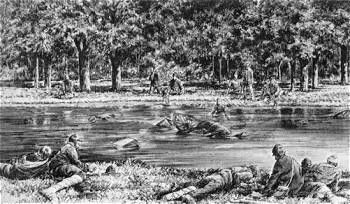
Even today, Bloody Pond has a natural reddish-brown tint to it.
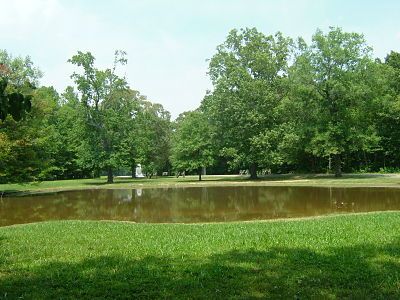
APR 7 The Battle of Shiloh: Second Day The 44th Indiana remains in camp until 11:00 AM when they are summoned to advance not far from their old bivouac and plug a gap in the Union line. About 3:00 PM Levi’s brigade commander, General Jacob Lauman, is sent an urgent message that they are to move up the Hamburg-Purdy Rd. south of the review field to assist General Gibson’s Brigade of General McCook's Division. Isaiah Wallick of the 49th Ohio is fighting in Gibson’s Brigade. It is very possible that both Isaiah and Levi are fighting on the same field at the same time at the Battle of Shiloh. When the Rebels see the reinforcements advance, they begin to withdraw from the field and the 44th will fight the rest of the day here and hold the position until nightfall. The whole Rebel line retreats and the two- day fight ends with the opposing forces basically in the same position as where they started. Combined Federal and Confederate casualties are 5,000 dead and 12,000 wounded, more American casualties than all its previous wars combined. The 44th Indiana throws 478 men into the two-day melee. Of that number, 33 are killed and 177 are wounded. It is a hollow victory for Grant. Although winner of the contest, his future is in doubt as Union commander because of the number of casualties he sustained in the battle and because he was so badly surprised by the Confederate Army.
Battleground between the Peach Orchard and the Hornets Nest - If Levi Wallick was on the battlefield at Shiloh, he would have fought in and around this field.
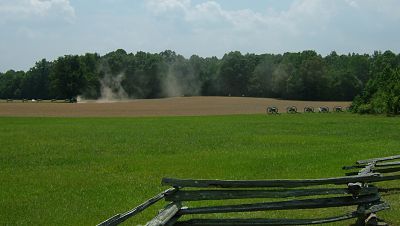
APR 29 – MAY 30 The 44th Indiana is part of an advance to Corinth, MS, driving the Confederates out of that vital railroad junction.
MAY 31 – JUN 12 Pursuit to Booneville, KY.
JUN – AUG The 44th is part of General Buell’s Northern Alabama and Middle Tennessee Campaign.
AUG 21 – SEP 26 Levi Wallick and his regiment march north to Louisville in response to General Bragg’s invasion of Kentucky.
OCT 1 – 7 The 44th Indiana continues to chase General Bragg and his Confederate forces through Loudon and central KY.
OCT 8 Battle of Perryville Levi and William Wallick are in the same corps and arrive in the early afternoon on the day of battle. Confederate forces under General Bragg begin their attack about 2:00 PM, hours behind schedule. The commander of the Union Army, General Don Carlos Buell, can hear very little of the canon fire at the opening of the engagement due to an acoustical shadow (a mysterious phenomenon caused by terrain and other factors where loud noises cannot be heard close by but can be heard miles away). General Buell does not realize that he is in a major engagement until 4:00 PM. He fails to engage over half his available force, which includes Levi's and William's regiments. Charles F. Wallick’s regiment, the 87th Indiana, is in the northern portion of the battlefield and they have their first taste of battle and also a terrible scare with friendly fire. It is near dark and due to poor visibility, Charles and the 87th Indiana nearly fire their muskets into the 2nd Minnesota Regiment, who is in front of them. General Buell is relieved of command after the battle because he lets the Confederates Army escape his grasp, even though he has an overwhelming advantage in troops.
OCT 22 – NOV 7 The 44th Indiana marches to Nashville, TN.
NOV 8 – DEC 26 Levi and his regiment have duty at Nashville, TN guarding railroads and Union supplies.
DEC 26 – 29 The 44th advances to Murfreesboro, TN.
DEC 31 Battle of Stone’s River: First Day The 44th Indiana is moved to the rear in reserve at the outset of the battle. The Confederates attack early in the morning and quickly rout the far right of the Union Army. Distant cousin Isaiah Wallick’s brigade is in one of the first engaged in the battle. They are totally surprised by the attack; many still eating their breakfast (see Isaiah Wallick at Stone’s River). At mid-morning Levi’s division is moved to the Nashville Pike and will become part of a strong defensive line established by the Union Army. William Wallick is also at Stone’s River and his brigade (under General Harker) is deployed adjacent to Levi’s (under General Fyffe). Levi's and William’s brigades will fight next to each other until William’s brigade is out-flanked and driven from the field. Levi’s brigade remains on the Nashville Pike Rd. until sundown, concluding the first day of battle.
1863
JAN 1 The Federal and Confederate armies wait for each other to move or attack. The previous day’s battle has exhausted the troops on both sides. Neither side initiates any offensive action and the first day of 1863 is a day of rest for the armies at Stone’s River. There is no change in either army's position on the field.
JAN 2 Battle of Stone's Rives: Second Day The stillness continues into the next morning but at 2:00 PM the Confederates begin an attack on the Union line to the right of Levi’s brigade. About 4:00 PM the Rebel army is advancing past the 44th Indiana and the Hoosiers deliver a withering fire into the flank to the passing Confederate brigade. Artillery is then fired into the advancing Rebel troops. At this point the 44th Indiana joins in a counterattack that drives the Confederate forces from the field. Levi’s regiment has 8 men killed, 52 wounded and 25 missing. The Rebels eventually retreat from Murfreesboro, in effect, leaving the Union Army in control of middle Tennessee.
The 44th Indiana Infantry crossed Stones River here on the second day of battle.
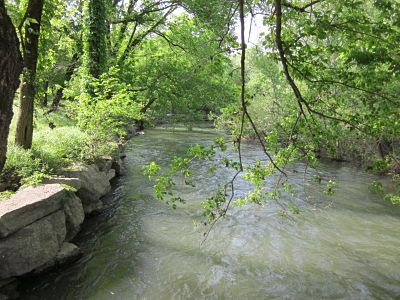
Site of McFadden's Farm at Stones River National Military Park,
where Levi's regiment fought late in the day on January 2, 1863.
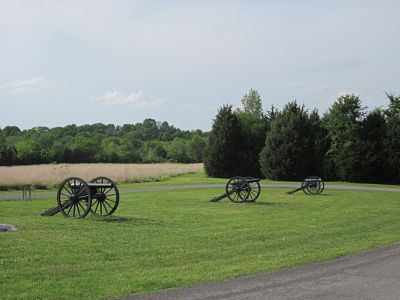
JAN – JUN Duty at Murfreesboro, a major supply base for the Federal Army.
JUN 23- AUG 16 The 44th Indiana is part of General Roscrans’s Tullahoma Campaign. This almost bloodless maneuver drives the Confederate Army out of middle Tennessee and into Chattanooga in east Tennessee.
AUG 17 – SEP Levi marches over the Cumberland Mountains and moves into northern Georgia with the 44th Indiana.
SEP 19 Battle of Chickamauga: First Day Three Wallicks will fight in this biggest battle of the western theater of the Civil War. Levi Wallick will be joined by distant cousins Charles F. Wallick of the 87th Indiana and Isaiah Wallick of the 49th Ohio. It is the largest two-day battle of the war and is only eclipsed by Gettysburg in the number of casualties and troops engaged. It is the Confederacy’s greatest victory in the west. Levi and the 44th Indiana begin the day of the engagement south of the battlefield at Gordon’s Mills. Early in the morning Charles F. Wallick will engage in the opening volleys of the battle at the north end of the battlefield. The battle will rage there all morning and by 1:00 PM Levi and his brigade will be moved up from Gordon Mills, form a line of battle east of Brotherton Field and aid in checking a fierce Confederate attack. There is heavy fighting all afternoon along the Union front and Levi’s brigade is finally pushed back. Charles F. Wallick’s brigade is moved from the Union left, down to the Union center, where Levi has been driven back by the Rebels. Around 3:15 PM the 44th is in savage fighting in Brotherton Field and are driven back beyond Glenn-Kelly Rd. They bivouac west of Dry Valley Rd (present day Lytle Rd.).
Monument to the 44th Indiana Infantry
Brotherton Field, Chickamauga National Military Park
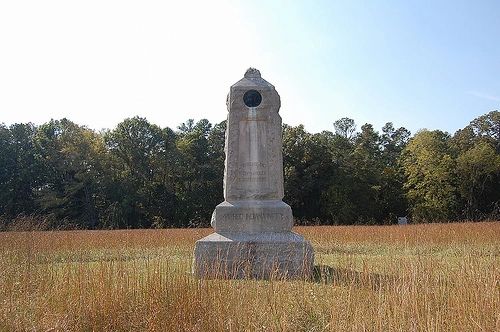
SEP 20 Battle of Chickamauga: Second Day At 10:00 AM Levi and the 44th Indiana are ordered to take a position west of Kelly Field. About an hour later they advance north and drive the Confederate up to McDonald House, where the Visitor’s Center is today. All three Wallick soldiers’ regiments will fight in and around Kelly Field in the early afternoon of September 20th. The Union army is maintaining their position in spite of the repeated Rebel assaults when one of the biggest battlefield blunders of the war is ordered by the Federal high command. An aid to General Rosecrans is passing behind the center of the Union line when he sees what appears to be a large gap between two brigades of the Union battle line. This is a wooded area of the battlefield and the aid fails to see that Charles F. Wallick’s division, which is concealed by the abundant underbrush. This erroneous gap information is passed on to General Rosecrans who orders two brigades moved out of the Federal line to plug a non-existing gap. In effect, he creates a gap in his own line to plug a gap that isn’t there. By chance the Confederates are determined to strike the Union line at that precise sector where the new gap was created by the Federal high command. There are no Union troops to resist the Rebel’s assault and the Confederate Amy makes a huge hole in the Federal line. This late morning breakthrough enables the Confederates to collapse the Union defense and force a retreat back towards Chattanooga. Charles F. Wallick’s corps commander, General George Thomas, has been amassing artillery throughout the day and he rallies his men and others (including Levi’s regiment) to make a stand on a small ridge southwest of Snodgrass House. In Federal records it is called Snodgrass Hill and in Confederate records it is called Horseshoe Ridge but, by whatever name, it is agreed that General Thomas made a stand here that saves the Union Army from destruction. It is for this action that he earns his nickname, “The Rock of Chickamauga.” Levi Wallick and the 44th Indiana are on the far left of the Union line on Snodgrass Hill and Charles F. Wallick and the 87th Indiana are near the opposite end of the Federal line. Whether Charles is still active on the field is uncertain for at some point in the battle he is wounded in his left hand and he must retire. At 4:30 PM the Confederates make an all-out attack against Levi and the 44th Indiana. They fight for about an hour and the Confederates sustain heavy losses in their uphill attack against massed Union artillery and infantry. This delaying action by General Thomas and his troops helps give the Union Army time for an orderly retreat. Without this action, the Union Army will be routed and destroyed. Levi and the 44th Indiana arrive in Chattanooga in the early morning hours of September 21.
Snodgrass House on Horseshoe Ridge - On this hill the 44th Indiana battled the surging Confederate forces long enough to provide an orderly retreat of the Union Army back into Chattanooga, Tennessee.
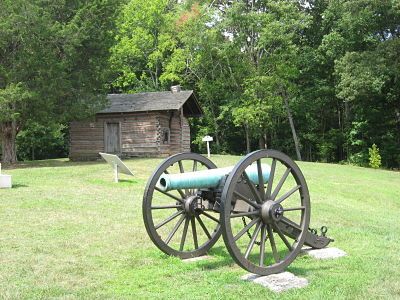
SEP 21 – NOV 7 The 44th Indiana is trapped in Chattanooga, TN with the Confederate Army occupying the hills that encircle the town. Supplies are very low with soldiers on half rations. General Grant is called from his very successful Vicksburg Campaign to help break the Confederate siege about Chattanooga. Grant’s arrival brings immediate changes to the Federals' morale and strategy. The supply problem is finally solved with a “Cracker Line” being established by ferrying supplies across Tennessee River into Chattanooga.
NOV 8 The 44th is assigned to provost (security) duty at the town of Chattanooga, TN. This duty takes them out of their previous brigades. They have been given light duty since they have fulfilled their three-year enlistment and are about to be mustered out of service. The regiments from their old brigade will be involved in the famous charge up Missionary Ridge on November 25, 1863. If the regiment had not been given provost duty, Levi would more than likely have been alongside Isaiah Wallick’s brigade as they charged up Missionary Ridge. During that charge Isaiah was mortally wounded and he died two days later in a Chattanooga army hospital. Charles F. Wallick’s brigade, the 87th Indiana, was also in the assault on Missionary Ridge, but he was on furlough, at home in Peru, IN recovering from a wound he received at the Battle of Chickamauga.
NOV 6 Levi has decided to reenlist as a veteran soldier in the 44th Indiana. The U.S. Government is desperate for men to extend their commitment because the war has taken much longer than first anticipated. If enough soldiers reenlist, the men can stay together as a veteran regiment, an important feature for the unit. If too few recommit, those who do reenlist will be assigned to other units as replacements, something distasteful to veterans. For reenlisting, Levi is promised a $400 bounty (payable at the whim of the government) and a thirty-day furlough home to Indiana. Levi begins his furlough on this date.
NOV 22 Three years to the day from their mustering-in at Ft. Wayne IN, the soldiers who did not re-enlist are mustered out of Federal service, free to return home. Levi and the others who did reenlist as veteran volunteers have been on furlough.
DEC 6 Levi returns to the 44th Indiana but is either sick or immediately gets sick Within ten days of his return he is admitted to a Nashville hospital for unknown reasons. The record does not show when he is discharged from the hospital.
1864
JAN 1 Levi officially signs his reenlistment papers as a veteran soldier. He will spend the rest of the war in and around Chattanooga, TN. This southeast Tennessee town is a vital Union supply center and a life-line to General Sherman’s Army for the next year as it moves through Georgia.
JAN 9 A description of Levi is recorded in the company roll and it is noted that he is owed $340 by the U.S. Government . For reenlisting he has been paid $60 of a $400 bounty (this is four times the money he received on his first enlistment). Soldiers did get paid, but very irregularly. By the first of the year it appears that some of Levi’s pay is to be withheld as reimbursement for passage home on his furlough; the cost for transportation from Nashville, TN to Louisville, KY is $3.80.
FEB – SEP The 44th is on provost duty at Chattanooga, TN.
SEP 28 – OCT 2 Levi and the 44th are sent to Tullahoma, TN for an unspecified service. Tullahoma is an important railroad junction in south-central Tennessee.
OCT 15 - DEC The regiment returns to Chattanooga and continues to have light duty in security.
1865
JAN - SEP Little is known about the activities of Levi and his regiment during their last nine months of service in the vicinity of Chattanooga. As exciting and eventful as their first enlistment was, their second enlistment appears to be quite uneventful with no major engagements, to the great delight of the veterans. The 44th Indiana moves to Nashville, TN and ends their enlistment there with little fanfare or drama.
Levi's regimental brothers from Company H, 44th Indiana Infantry
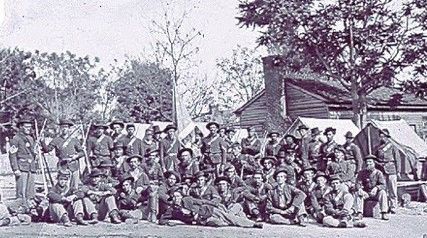
SEP 14 Levi and the 44th Indiana are mustered out of Federal service in Nashville, TN. There is a notation concerning Levi in the company roll stating, “Retained under General Order 101, one Enfield rifled musket and accoutrements: price, $6.00.” In almost four years of service with the 44th Indiana, 4 officers and 76 enlisted men have been killed or mortally wounded. An additional 9 officers and 220 enlisted men have died of disease.
Pictured are two of Levi Wallick's compiled service cards from the National Archives. The muster-in card records his place of birth as Tuscarawas County, Ohio. When he leaves the service he is able to take with him his Enfield rifle for $6.00.


Levi Wallick’s paper trail is lost after September 14, 1865, when he is discharged from the 44th Indiana Volunteer Infantry. He is mentioned in an 1866 estate document, but that is the only record to cite his name once he exits from the army. No one knows when Levi died or where he is buried, or what he did after the war. After 1866 he is lost to history. The record of Levi Wallick as a soldier is rich with information, placing him in specific places at exact points in time. What a contrast to what we know about Levi Wallick, the civilian. It is hoped that someday more documentation will be discovered about the antebellum and post-war life of this soldier.
Comrades-in-Arms
Cousins
Michael 27th IN
David 139th OH
Daniel 20th OH
Elijah 102nd OH
David H 102nd OH
Henry 67th OH
Return to Top
Return to
Wallick Family Website

















